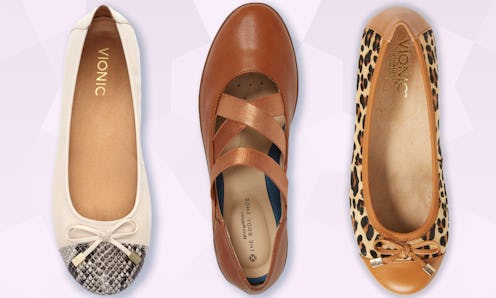Fashion
If You Have Bunions, These Are The Only Ballet Flats Worth Buying

If you suffer from bunions, wearing the wrong type of shoes can add unwanted pressure or pain to the big toe area — and this means shoe shopping can be a challenge. To make your search for bunion-approved shoes a little easier, I've compiled a research-backed list of the best ballet flats for bunions. They've got podiatrist-recommended features that'll leave your feet feeling comfortable all day.
First, a little background: Wearing too-tight or too-narrow shoes can add pressure and worsen bunions. That said, a major factor to look for when choosing flats is a toe box that's wide and not pointed. Dr. Frank Sinkoe, an Atlanta-based podiatrist, agrees. What's more, he tells Bustle, limiting motion in the big toe joint can help with pain. How do you limit big toe movement? Opt for closed-toed shoes that cover the entire toe area. Dr. Sinkoe also recommends wearing supportive shoes for bunions, so it's a good idea to opt for extra support or padding in the insole.
All the shoes below are comfortable and supportive, and many offer wider toe boxes to minimize the risk of irritation. And just because they're good for your feet doesn't mean they lack style — I've included a range of cute options at various price points.
1The Overall Best Ballet Flats For Bunions Considering Features, Reviews, & Quality
While Vionic's Spark Minna ballet flats are on the pricier side, at $75 a pair, they're the best choice if you're able to spend a bit more on a reputable brand. Vionic's shoes are specifically made to add extra support, alignment, and cushioning for chronic foot issues.
This leather pair features a rounded-toe (with a small bow at the end) and the brand's signature microfiber EVA footbed for superior comfort. It comes in 17 different color and pattern options and boasts more than 600 reviews on Amazon.
What bunion sufferers say: "These are comfortable and very attractive shoes. They are the typical Vionic shoe that feels so good on your feet. Enough arch support and foot padding. The curve does not hurt if you have a cross over toe and it does not irritate my bunion."
- Available sizes: 5 - 11
2Supportive Flats For Bunions That Won't Break The Bank
For a more affordable option that still offers support, a pair of these flats by Cior will do. They're made with suede leather and have a rubber sole, but their a breathable inner lining and supportive footbed are what makes them great for bunions.
The rounded-toe design, which boasts a four star rating on Amazon, comes in 21 color choices and has a small, 1/4-inch platform on the heel to dress it up.
What bunion sufferers say: "This has become my summer go to shoe. Comfortable, stylish, and easy to wear. Delivered early and more importantly, comfortable all day wear, to include my bunion."
- Available sizes: 4.5 - 9.5
3Affordable Ballet Flats That Are Comfortable & Come In Wide Widths
The wildly-popular flats are a solid choice for super-comfortable and supportive flat shoes at a moderate price. Made with a soft faux-leather microfiber and a rubber sole for added traction, this trendy option features a small platform on the heel and a slightly-beveled fit for better weight distribution while walking.
Even better? These flats come in wide width sizes, making them more comfortable for bunion sufferers. You can get them in 15 different colors and patterns.
What bunion sufferers say: "I got these as I was looking for a basic pair of flats for daily wear. I was concerned that they might be uncomfortable on me, as most flats of this type cut right across my bunions and cause extreme pain. Not so with these shoes! After the first time or two of breaking them in, they fit like a dream and are comfortable for all day wear."
- Available sizes: 5 - 15 (regular and wide)
Bustle may receive a portion of sales from products purchased from this article, which was created independently from Bustle's editorial and sales departments.
This article was originally published on